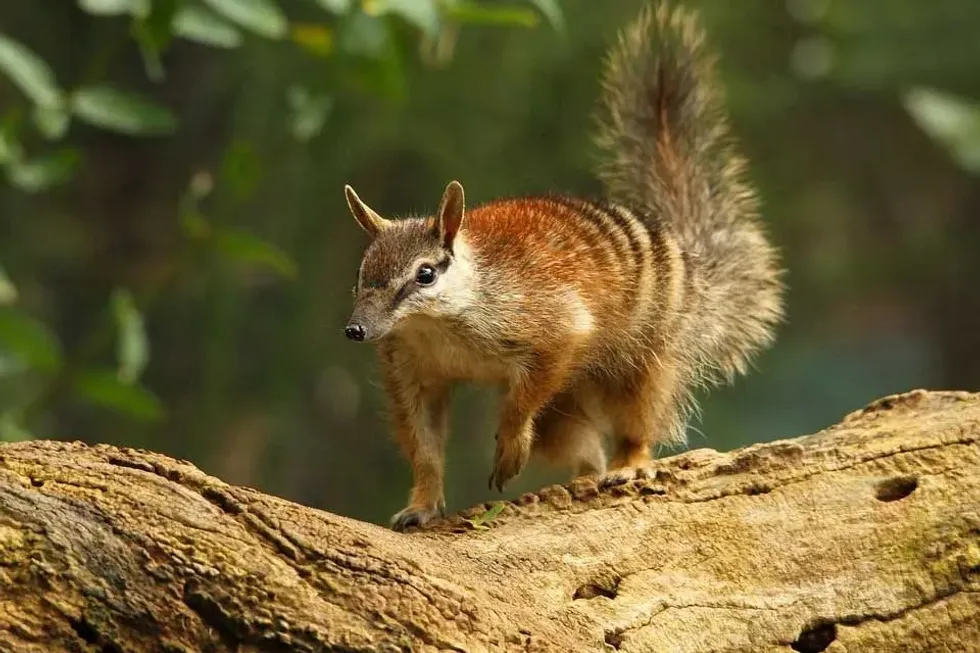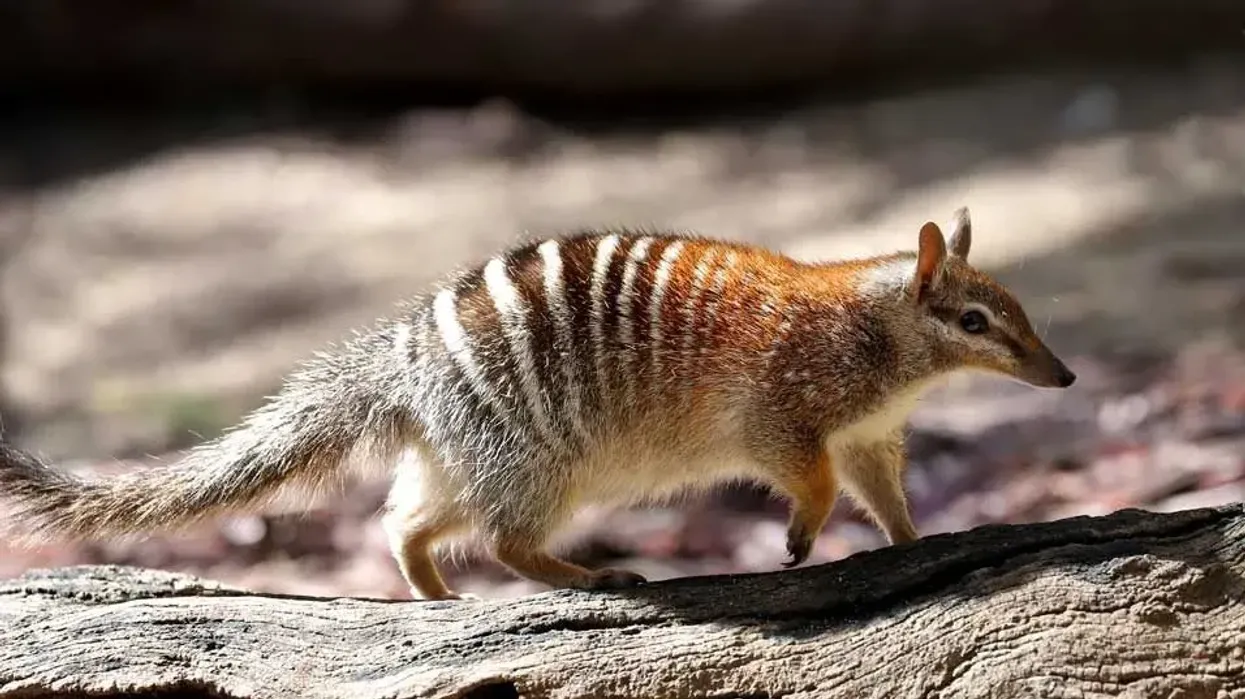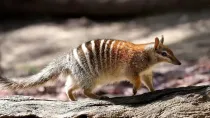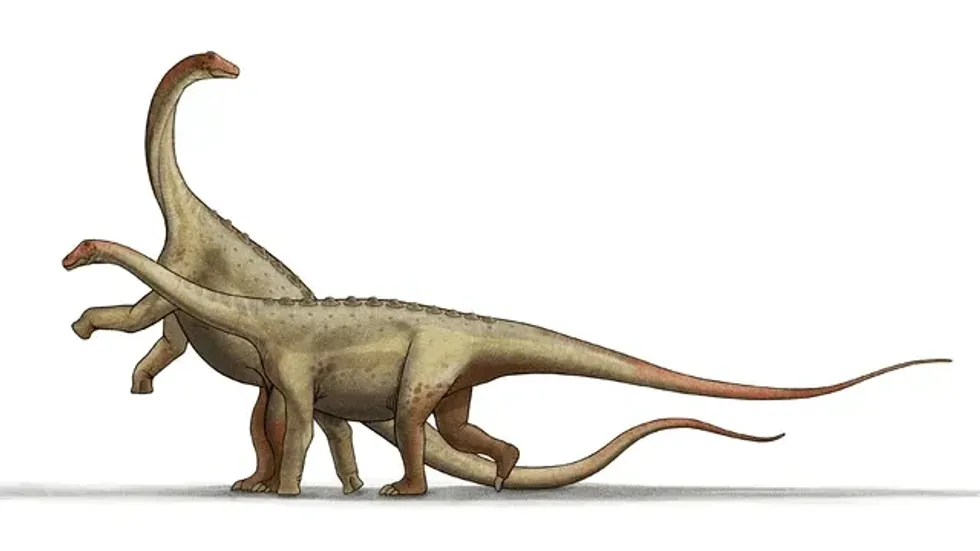Fun Numbat Facts For Kids

Numbats are not bats. Numbats are marsupials, but they do not have a pouch for their babies.
Numbats are not nocturnal and are active during the day when the termites are active. The numbat is also known as the banded anteater, but it does not eat ants (except incidentally) and eats termites with its long sticky tongue. Fallen tree hollow logs in the woodlands are habitats that numbats prefer to live in.
The scientific name of a numbat is Myrmecobius fasciatus. Numbats are small brownish red-coated adorable animals with white stripes and are a native species of South Australia.
Hence they are also called the Australian numbat. Numbats are solitary, territorial animals and live in a wide range of homes. Because they need many termites to survive, Numbats set their territories for survival and protect them from other Numbats.
The numbat is on the endangered list, according to the IUCN Red List. The numbat population has reduced to less than one percent of their former range and is now found in only South-West Western Australia.
If you find our numbat facts fascinating then also check our other articles on gundi facts and elephant shrew facts.
Numbat Interesting Facts
What type of animal is a numbat?
The numbat is a small diurnal marsupial carnivorous animal, active during the day. The numbat is one of the four anteater species that eats only termites as its diet. Numbats are now endemic to western Australia and nearby areas.
What class of animal does a numbat belong to?
Numbat belongs to the class Mammalia and Myrmecobiidae family. One of the two species belonging to the Myrmecobius Genus's family is the Myrmecobius Fasciatus Rufus, which is now extinct.
The other is known as the Myrmecobius Fasciatus, commonly known as the numbat. Numbats are diurnal marsupials without a pouch. Over a million years of morphological adaptation have separated this numbat from other marsupials.
How many numbats are there in the world?
It is unfortunate to know that the numbats' total population is less than 1000, and the population of adult numbats is decreasing. Numbats are mainly seen in Southern Australia and parts of Western Australia.
Australian authorities protect numbats' population within large, feral predator-free fenced areas at Yookamurra, Mt Gibson, Scotia Wildlife Sanctuaries, and Mallee Cliffs National Park. Other organizations like Project Numbat, WWF, and Numbat Task Force, work on breeding them in captivity and protecting adult numbats in wildlife to increase their population.
Where does a numbat live?
Numbats live in hollow tree logs or borrow in the ground in woodland and forests for both shelter and prey. They live in large hollow logs or construct a short burrow with a small chamber at the end where it makes its nest with flowers, leaves, shredded bark, and leaves.
The numbat blocks the opening of its nest with the thick hide of its rump, to protect the nest.
What is a numbat's habitat?
Naturally, numbats live in different habitats, from Mulga Woodland and Spinifex Sandplains to Eucalypt woodlands and forests. Numbats were previously found widely in Arid and Semi-Arid Southern Australia. But now are found in the wild only in the dry patches of Dryandra Woodland and the Peru Nature Reserve in Western Australia.
Who do numbats live with?
Numbats are solitary animals and predators of termites. And because they eat termites, almost 20,000 termites at a time, they do not like to share their only diet and the territory where termite mounds are found.
The male numbat territory ranges from 25-50 hectares to meet its food needs. Except to mate, adult numbats stay on their own, and the dependent offspring stays with their mother.
How long does a numbat live?
The life span of a numbat is five years in the wild if not eaten by a predator, but can live longer in captivity. After birth, young numbats are attached to their mother's teats for six months.
After which, they are protected in the nest for another six months exploring the surroundings before becoming independent by the age of 10-12 months to live on their own.
How do they reproduce?
The female numbat reaches sexual maturity by 12 months, whereas the male reaches maturity by two years of age. The mating system is polygynous, where a male mates with multiple females.
The gestation period is short of about 14 days producing 2-4 offsprings. These attach to the teats of the mother.
These particular marsupials do not have a pouch, so the mother carries the young ones for as long as six months till she can carry them no more. They breed in autumn, once in a year, but if the litter gets destroyed for some reason, then the females can reproduce another one.
What is their conservation status?
According to the IUCN Red List, the numbat is an endangered species. The population of numbats drastically reduced in recent times.
Once numbats were found across Southern Australia and New South Wales, but their populations are now limited to few areas of Eucalyptus woodlands of Western Australia. Thanks to sanctuaries and Australian authorities' active role in conserving this species, their number is increasing, and one can also find them in DryandraWoodlands near Narrogin and Peru Nature Reserve.
Numbat Fun Facts
What do numbats look like?
Numbats are small colorful lovely marsupials species with bushy tails. Its color varies from black-grey to brick red-orange with a finely pointed muzzle and stiped hairy skin; its color varies from black-grey to brick red-orange.
It has round-tipped ears, and the underneath is in lighter shades of grey or cream.
These animals are ground-dwelling and are found around fallen trees, an essential part of a numbat habitat. Hence, the skin helps them easily dwell in the surroundings of fallen trees and leaves on the ground to help protect themselves from predators.

How cute are they?
A numbat is an adorable little creature. Numbats have a cute black and white pattern over their rump with orange and grey fur, and their tails confuse an onlooker for a giant squirrel.
How do they communicate?
Numbats use different types of vocalizations for communication. A mother makes a slight chirping sound to communicate with her offspring when it comes out of its nest.
A hissing growl is made for protecting its territory from other numbats. Simultaneously, a loud altercation is heard when the Numbats are under stress and disturbed; especially females use this loud growling to reject a male's unwanted advancement. But when together for breeding, both the numbats produce soft clicks.
How big is a numbat?
Numbats grow between 17.5cm-27.5cm long, including their bushy tail, and 13cm-18cm tall. Numbats are as big as rabbits and bigger than squirrels found in the wild, living in hollow logs. Numbats weigh between 280 grams to 700 grams. At the time of birth, a numbat is just 2 cm.
How fast can a numbat run?
When threatened, numbats can run at speed up to 32 km per hour to hide in a burrow or a log. If one is in South Australia and finds an animal with a bushy tail disappear suddenly, it is possible to think of it as a squirrel. As such, they are land-dwelling animals and have swift movements.
How much does a numbat weigh?
Numbats weigh between 280 grams to 700 grams. Numbats are small marsupials and are no larger than a wild hare. Even then, a mother carries one to four pups till they reach six months of age.
What are their male and female names of the species?
No special terms for male and female numbats are specified. They are just called male numbat and female numbat.
Also, there is no collective term for the Numbats' group, mainly because these are solitary animals and do not gather in groups. And even if they are found in a particular place together, they are termed as the colony of numbats. Numbats are also called Noombat or Walpurti.
What would you call a baby numbat?
Baby numbats are termed as pups. After a gestation period of only 14 days, the newborns are attached to their mother's teats.
Numbats carry her pups attached to their teats for as long as she can carry since, like other marsupials, numbats do not have pouches. In the absence of a pouch, the babies are protected by a patch of golden crimped hair along with the swelling of the abdomen and thigh muscles during the period of lactation.
What do they eat?
Numbats' diet mainly consists of termites. They do not eat ants except incidentally.
They eat almost 20,000 termites in a day. Unlike other marsupials, which are nocturnal, numbats are diurnal.
This is mainly because of their food, as termites are active in the daytime. Numbats do not depend on water because their hydration from termites is sufficient for their survival. That is why their kidneys are also different.
When termites are active and move in a network of shallow tunnels, numbats detect them with their strong sense of smell. Using their front paws, numbats scrape the soil and lick them with their long sticky tongues, which are almost 10 cm long.
With adapted morphology due to the numbat diet, the numbat tongue is long along with its lower jaw. They do not chew the termites, instead, swallowing them, that is why, though numbat teeth count is around 50, they are all underdeveloped.
Are they dangerous?
Numbats are not aggressive animals but are alert against any predation. The males compete with each other during the breeding season, competing for females.
Would they make a good pet?
One can not have a numbat as a pet. Because the numbat population is protected under Australian law, no one is allowed to capture it for any reason. So one can not have a numbat pet.
Did you know...
The faunal emblem of Western Australia is a numbat.
Another Australian marsupial, the Musky Rat Kangaroo which feeds on fruits from the forest floor is also strictly diurnal.
These animals are marsupial but lack a pouch and are diurnal, unlike others.
Living in an arid environment, numbats do not have to drink water, and they get all the required hydration from their food, eating almost 20,000 termites a day. They prey on underground termites with their strong sense of smell.
Are numbats endangered?
Numbats are endangered species. Once numbats were widely found in Southern Australia and New South Wales, but numbats' numbers drastically fell and they are now found in Western Australia's small pockets.
No more than 1000 adult numbats exist today in the wild. They are small diurnal marsupial predated by as many predators.
Also, deforestation, ground clearance, and felling of trees for agriculture and plantations and forest fires caused due to climate change are taking away numbats' habitat and decreasing their population drastically.
But the Australian government has declared numbats as a species that is protected under the law. Many organizations have taken numbat protection seriously and are taking the required measures and steps to breed them in captivity and protect them in the wild in predator-free sanctuaries in Australia.
What are the numbat's predators?
Numbats have many enemies. As they are active during the day and search for termites on the ground and under fallen trees and surrounding areas, they are prey to birds of prey, reptiles, and more such animals.
Predators like falcons, collared sparrow hawks, wedge tailed eagles, carpet pythons, goannas, foxes, and cats are all predators of the numbat. The population threat of numbats can be credited to these many predators.
When Europeans settled in Australia, they introduced predators to the habitat, mainly feral cats and dogs. Fortunately, the numbat is now being bred and protected in sanctuaries such as Scotia Sanctuary and Yookamurra Sanctuary in Australia.
Here at Kidadl, we have carefully created lots of interesting family-friendly animal facts for everyone to discover! Learn more about some other mammals including Chinese hamster, or shrew.
You can even occupy yourself at home by drawing one on our numbat coloring pages.
We Want Your Photos!
More for You
See All
Bachelor of Arts specializing in Linguistics

Martha MartinsBachelor of Arts specializing in Linguistics
Martha is a full-time creative writer, content strategist, and aspiring screenwriter who communicates complex thoughts and ideas effectively. She has completed her Bachelor's in Linguistics from Nasarawa State University. As an enthusiast of public relations and communication, Martha is well-prepared to substantially impact your organization as your next content writer and strategist. Her dedication to her craft and commitment to delivering high-quality work enables her to create compelling content that resonates with audiences.
Bachelor of Arts specializing in Psychology

Shreya YadavBachelor of Arts specializing in Psychology
Shreya has developed a diverse set of skills through her experience in client servicing, email marketing, content and e-commerce management, digital marketing, and creative content writing. Her educational background includes a Bachelor's degree in Psychology from Indira Gandhi National Open University, Delhi. Shreya's passion for ongoing learning and development is a testament to her commitment to excellence.
Disclaimer
1) Kidadl is independent and to make our service free to you the reader we are supported by advertising. We hope you love our recommendations for products and services! What we suggest is selected independently by the Kidadl team. If you purchase using the Buy Now button we may earn a small commission. This does not influence our choices. Prices are correct and items are available at the time the article was published but we cannot guarantee that on the time of reading. Please note that Kidadl is a participant in the Amazon Services LLC Associates Program, an affiliate advertising program designed to provide a means for sites to earn advertising fees by advertising and linking to Amazon. We also link to other websites, but are not responsible for their content.
2) At Kidadl, we strive to recommend the very best activities and events. We will always aim to give you accurate information at the date of publication - however, information does change, so it’s important you do your own research, double-check and make the decision that is right for your family. We recognise that not all activities and ideas are appropriate for all children and families or in all circumstances. Our recommended activities are based on age but these are a guide. We recommend that these ideas are used as inspiration, that ideas are undertaken with appropriate adult supervision, and that each adult uses their own discretion and knowledge of their children to consider the safety and suitability. Kidadl cannot accept liability for the execution of these ideas, and parental supervision is advised at all times, as safety is paramount. Anyone using the information provided by Kidadl does so at their own risk and we can not accept liability if things go wrong.
3) Because we are an educational resource, we have quotes and facts about a range of historical and modern figures. We do not endorse the actions of or rhetoric of all the people included in these collections, but we think they are important for growing minds to learn about under the guidance of parents or guardians.







